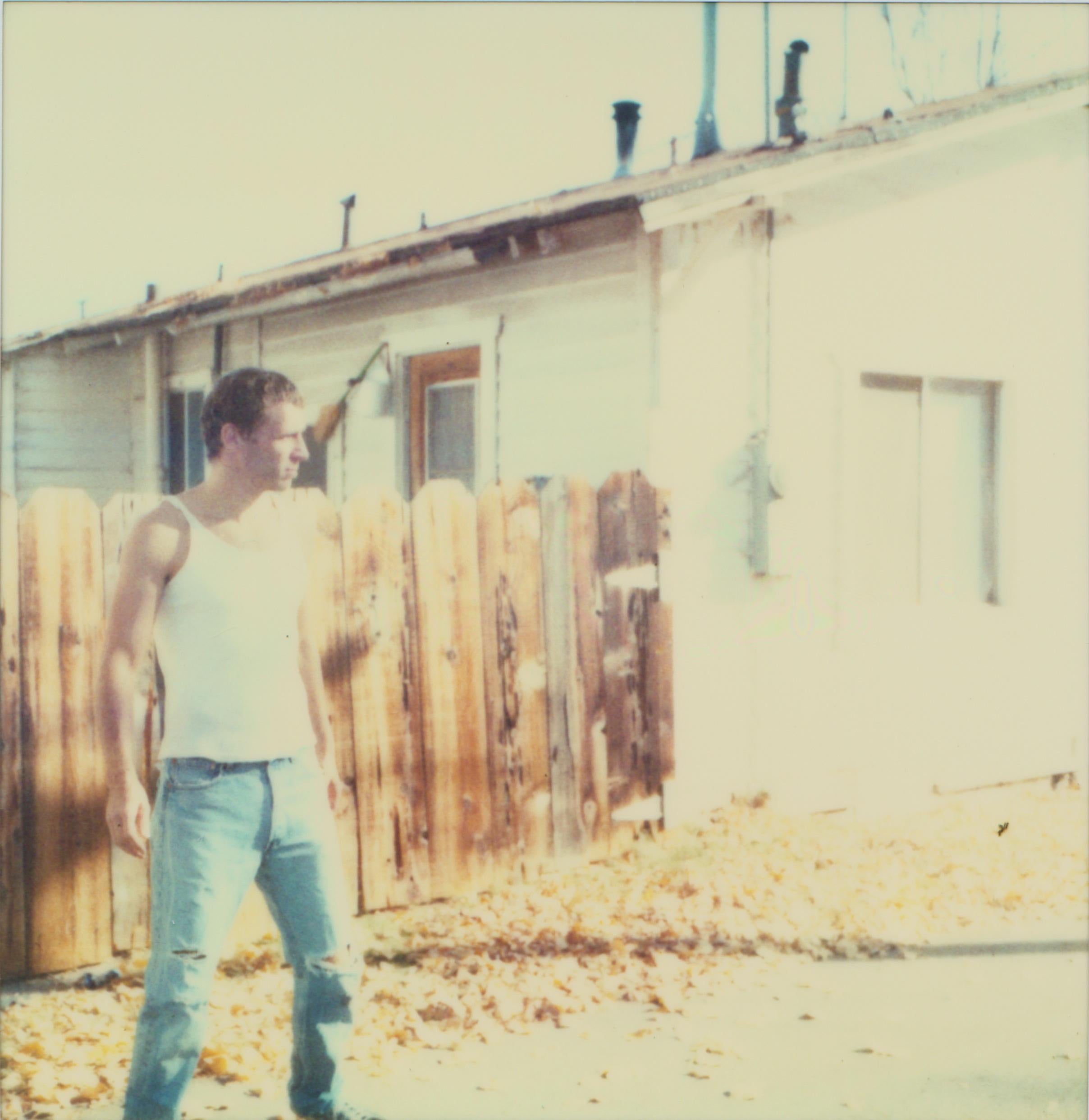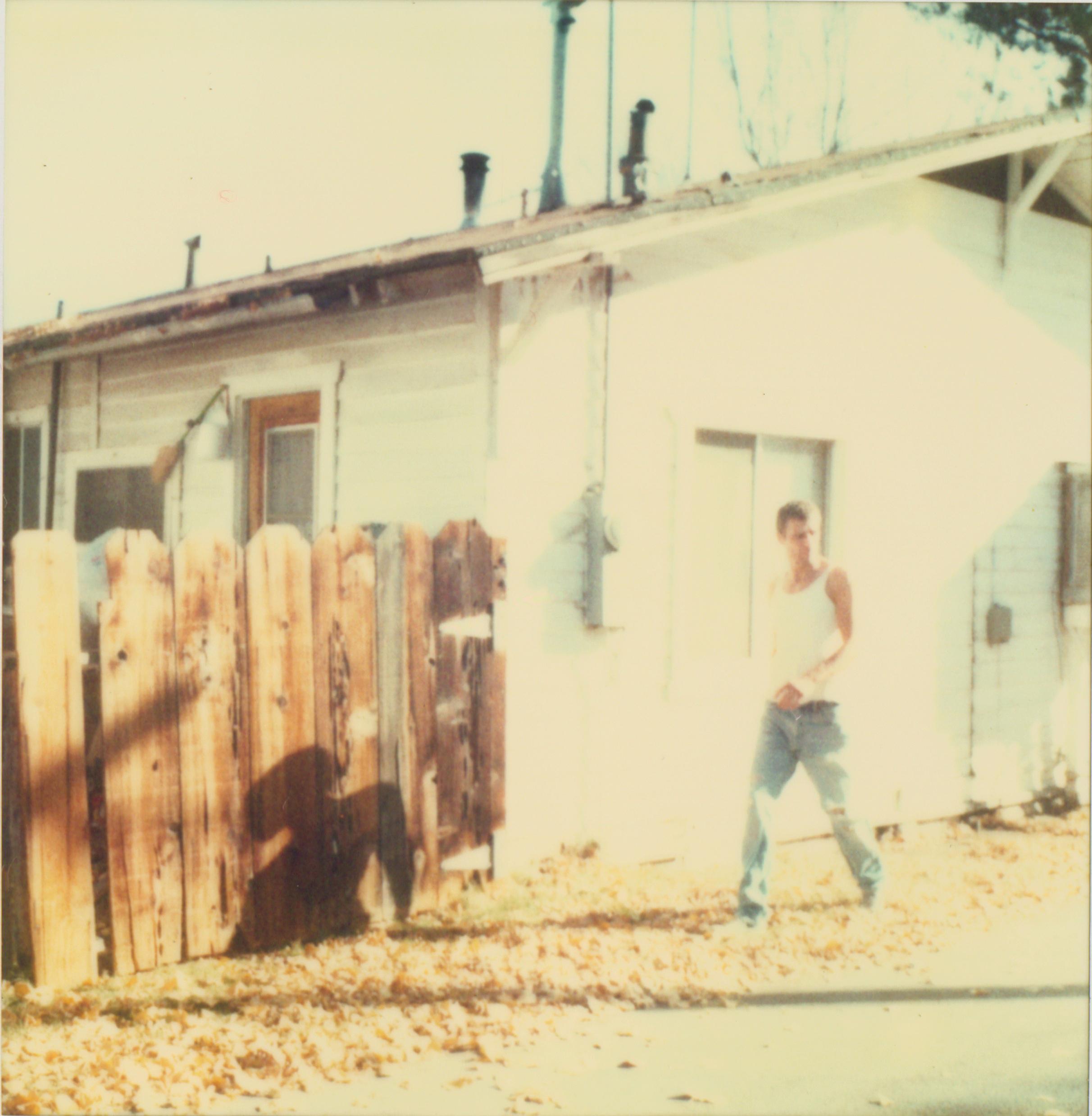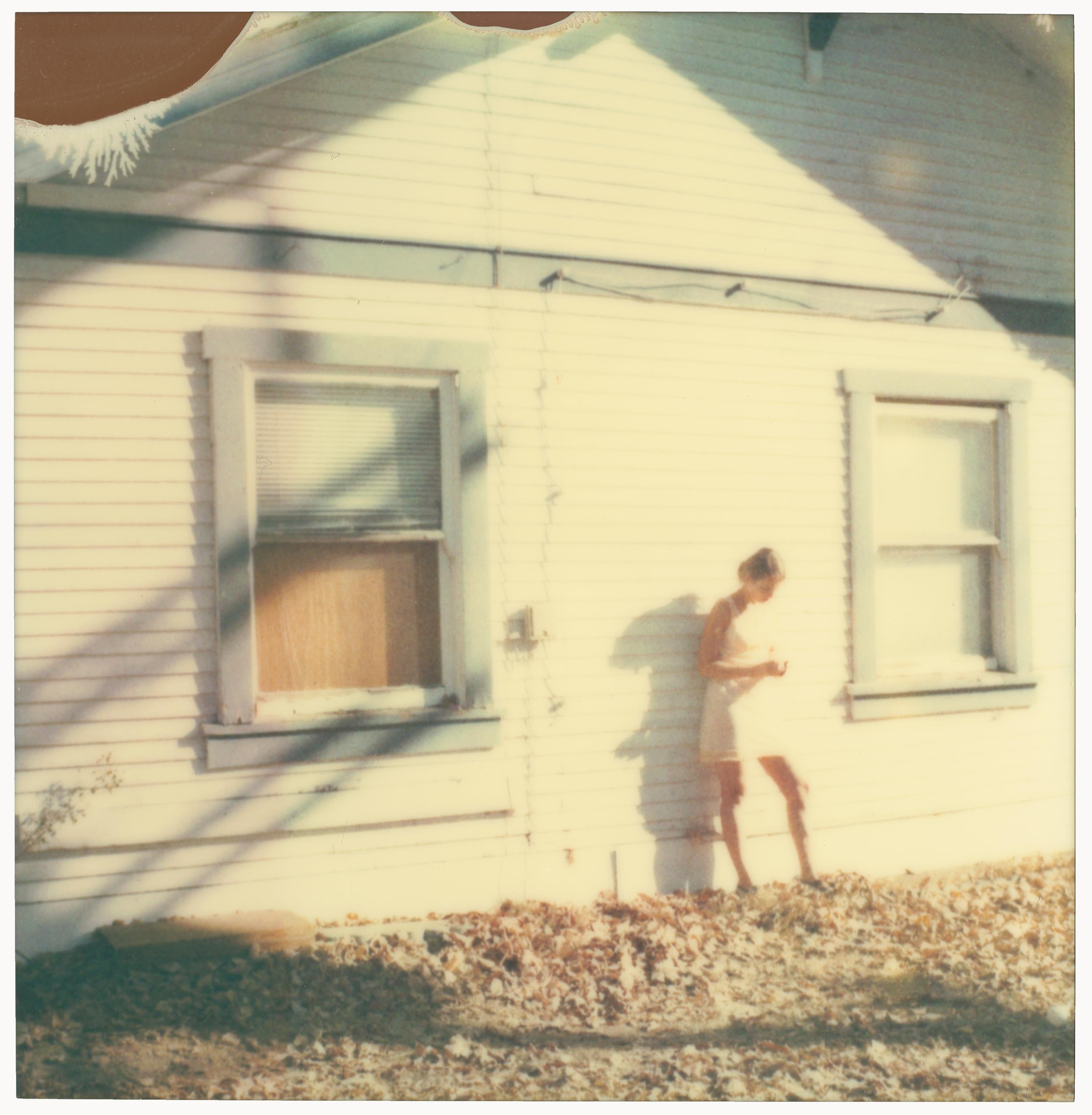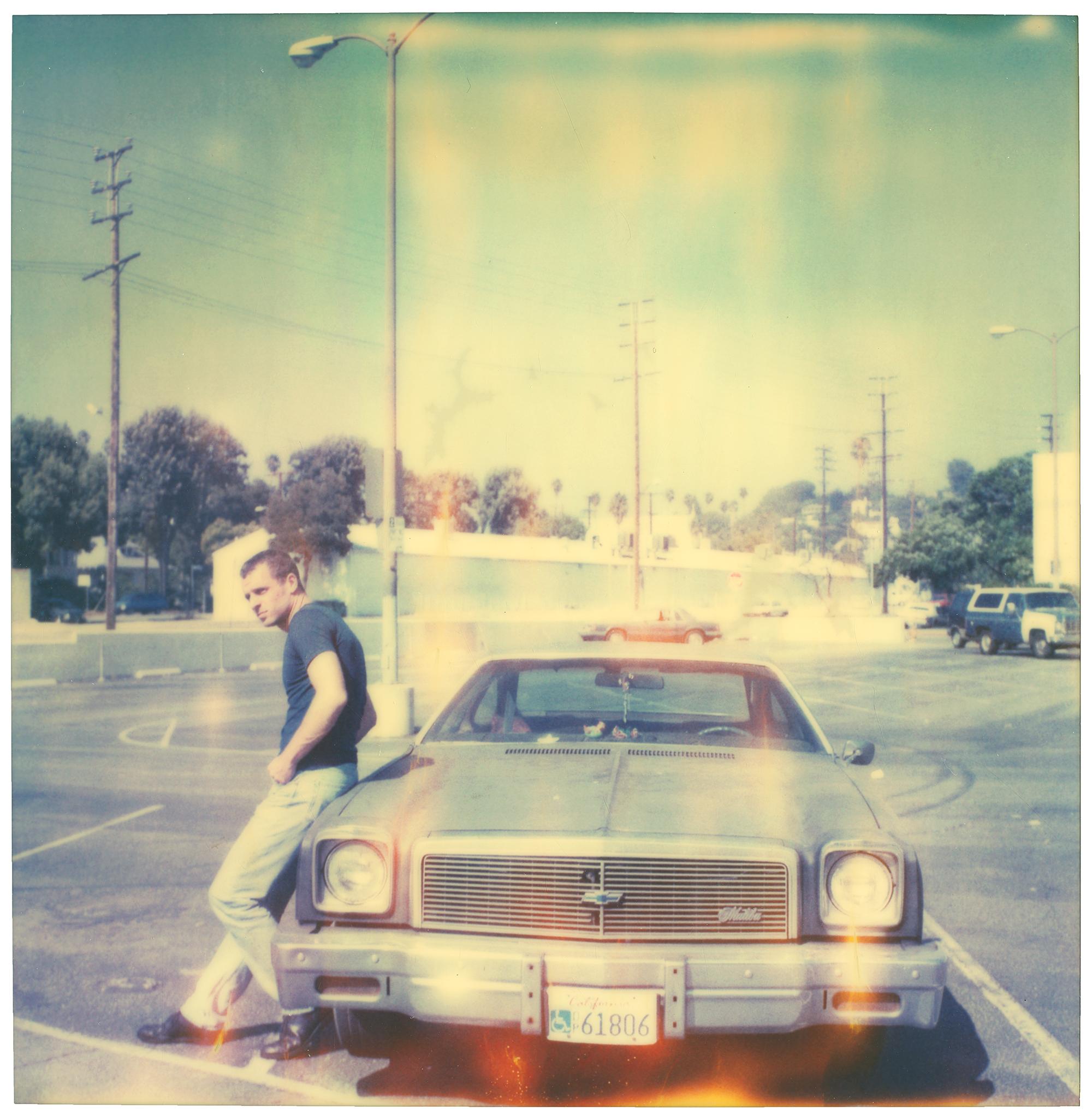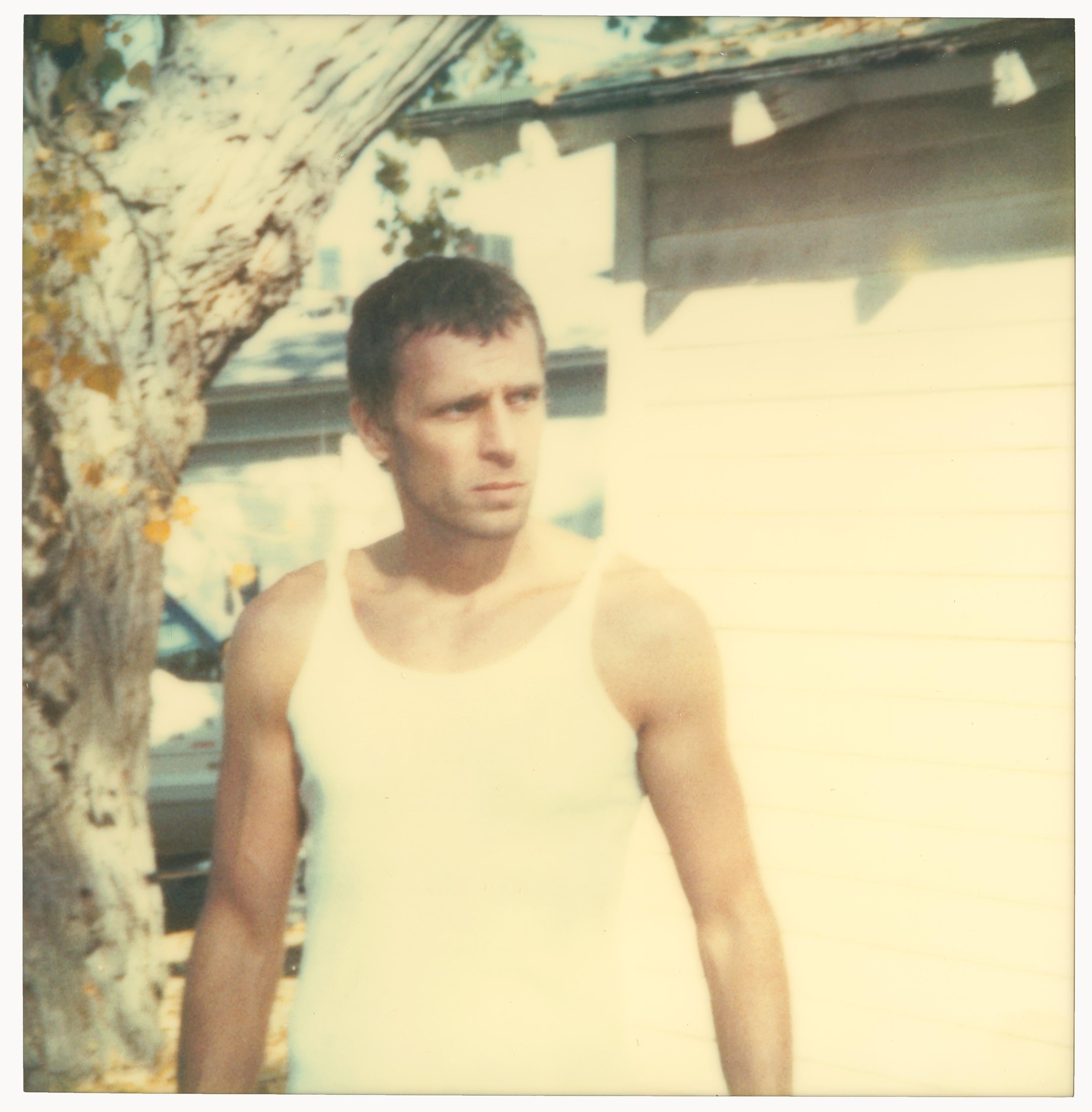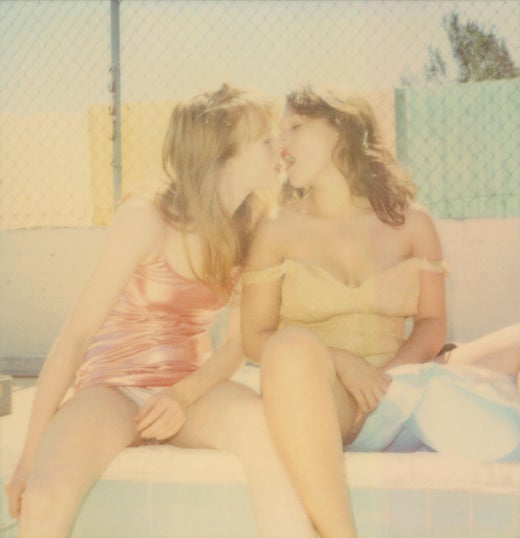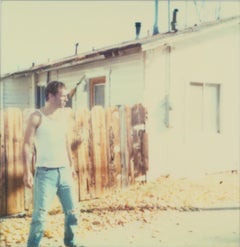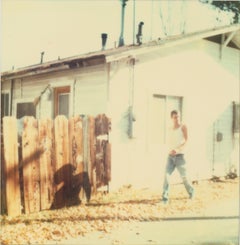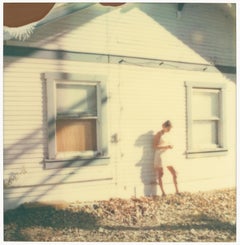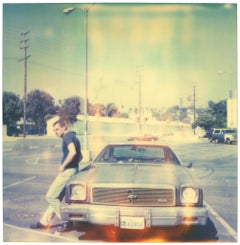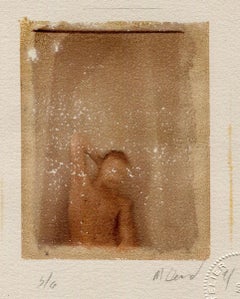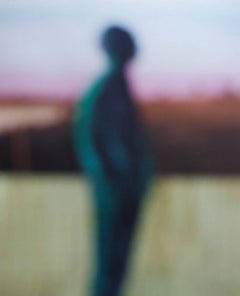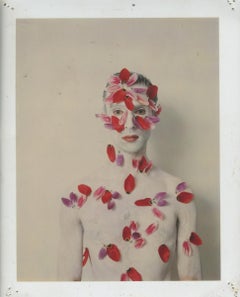Items Similar to Afternoon Drifter (The Last Picture Show) - 21st Century, Polaroid, Color
Want more images or videos?
Request additional images or videos from the seller
1 of 5
Stefanie SchneiderAfternoon Drifter (The Last Picture Show) - 21st Century, Polaroid, Color2006
2006
$2,000
£1,515.89
€1,754.79
CA$2,823.48
A$3,144.17
CHF 1,641.64
MX$38,097.45
NOK 20,702.85
SEK 19,534.77
DKK 13,099.27
About the Item
Afternoon Drifter II (The Last Picture Show) - 2006
58x57cm,
Edition of 10 plus 2 Artist Proofs.
Analog C-Print, hand-printed by the artist on Archive Fuji Chrystal Paper, based on the original Polaroid.
Artist inventory number: 1011.
Signature label and certificate.
Not mounted.
Published by STRANGER THAN PARADISE published by hatje cantz verlag, Ostfilder, 2006, (monograph)
The works of Stefanie Schneider evoke Ed Ruscha's obsession with the American experience, the richness of Georgia O'Keefe's deserts and the loneliness of Edward Hopper's haunting paintings. So how exactly did this German photographer become one of the most important artists of the American narrative of the 20th and 21st century?
Stefanie Schneider was born and raised in Germany but lives and works in Southern California. Exploring the American dream and capturing it with Polaroid instant film. Situated on the verge of an elusive super-reality, her photographic sequences provide the ambiance for loosely woven storylines and a cast of phantasmic characters that reflect a part of the narrator's life told from her perspective. Often about love, communication. sexuality and relationships. Schneider works with the chemical mutations of expired Polaroid film stock. Chemical explosions of color spreading across the surfaces undermine the photograph's commitment to reality and induce her characters into trance-like dreamscapes. Like flickering sequences of old road movies, Schneider's images seem to evaporate before conclusions can be made - their ephemeral reality manifesting in subtle gestures and mysterious motives. Schneider's images refuse to succumb to reality, they keep alive the confusions of dream, desire, fact, and fiction yet they also explore the relationship between the medium and the viewer. The wabi-sabi 'ness' of Schneider's work can not be denied or ignored. It's a step of acceptance of 'flaws', gaps, and distortions. Missing pieces of the puzzle. The artist flaunts, uses, and exposes the unknown using expired Polaroid instant film intentionally. Presents it. What you do with that is up to you. That missing part of the picture is for you to include yourself, you fill it in with yourself. That might be critical that it's there at all, missing and missing the entire point altogether or by filling in the unknown with their own imagination. Even their own memories then integrate the viewer and artist as one with limitless potential.
Stefanie Schneider's new photographic works tell fantastic stories about her adopted Californian home. She seeks out faded American myths and distills a charged reality in a very personal and surprising way. She uses out-of-date Polaroid film, and the blemishes caused by the degenerated film stock, - are included in the composition in a painterly way. Exposure mistakes and low budget movie effects are combined to alienating effect. Everything shimmers and flickers before our eyes. The artist plays with the authentic poetry of the amateur, mixing strangely dreamy staging with random photochemical events. In the 16-part work Frozen, which is characterized by a strangely transcendent mood in the lighting, film-still-like pictorial clusters come together to form a mysterious story, with the artist herself as the lonely protagonist. the aesthetic is reminiscent of early Lynch films. The components of the elliptically choreographed events are scenes from an enchanted, gleaming winter landscape, together with "staged snapshots" of a pale young woman in her underskirts, who radiates the troubled reality of a mirage with her sleep walking presence. The story is presented in the manner of cinematic flashbacks or dream sequences. Stage blood and a knife are used to evoke a crime of passion whose surreal attractiveness is derived from the scenic openness of what is shown. The deliberate use of old instant picture stock establishes in a richly faceted way the ephemeral quality of vulnerability and transience within a reality that is brittle from the outset. The American Stars and Stripes, recently updated as the absolute epitome of a patriotic signifier, is the subject of the 9-part work Primary Colors (2001). Schneider's reassuringly European view, free of undue emotion, presents the Stars and Stripes motif in a strangely alienated form: she shows stills with phases of fluttering violently in the wind, even torn in some cases, and the expired film stock emphasizes the fragility of the icon even more.
FlashART - Sabine Dorothee Lehner (translated from German by Michael Robinson)
Published by STRANGER THAN PARADISE published by hatje cantz verlag, Ostfilder, 2006, (monograph)
The works of Stefanie Schneider evoke Ed Ruscha's obsession with the American experience, the richness of Georgia O'Keefe's deserts and the loneliness of Edward Hopper's haunting paintings. So how exactly did this German photographer become one of the most important artists of the American narrative of the 20th and 21st century?
Stefanie Schneider was born and raised in Germany but lives and works in Southern California. Exploring the American dream and capturing it with Polaroid instant film. Situated on the verge of an elusive super-reality, her photographic sequences provide the ambiance for loosely woven storylines and a cast of phantasmic characters that reflect a part of the narrator's life told from her perspective. Often about love, communication. sexuality and relationships. Schneider works with the chemical mutations of expired Polaroid film stock. Chemical explosions of color spreading across the surfaces undermine the photograph's commitment to reality and induce her characters into trance-like dreamscapes. Like flickering sequences of old road movies, Schneider's images seem to evaporate before conclusions can be made - their ephemeral reality manifesting in subtle gestures and mysterious motives. Schneider's images refuse to succumb to reality, they keep alive the confusions of dream, desire, fact, and fiction yet they also explore the relationship between the medium and the viewer. The wabi-sabi 'ness' of Schneider's work can not be denied or ignored. It's a step of acceptance of 'flaws', gaps, and distortions. Missing pieces of the puzzle. The artist flaunts, uses, and exposes the unknown using expired Polaroid instant film intentionally. Presents it. What you do with that is up to you. That missing part of the picture is for you to include yourself, you fill it in with yourself. That might be critical that it's there at all, missing and missing the entire point altogether or by filling in the unknown with their own imagination. Even their own memories then integrate the viewer and artist as one with limitless potential.
Stefanie Schneider's new photographic works tell fantastic stories about her adopted Californian home. She seeks out faded American myths and distills a charged reality in a very personal and surprising way. She uses out-of-date Polaroid film, and the blemishes caused by the degenerated film stock, - are included in the composition in a painterly way. Exposure mistakes and low budget movie effects are combined to alienating effect. Everything shimmers and flickers before our eyes. The artist plays with the authentic poetry of the amateur, mixing strangely dreamy staging with random photochemical events. In the 16-part work Frozen, which is characterized by a strangely transcendent mood in the lighting, film-still-like pictorial clusters come together to form a mysterious story, with the artist herself as the lonely protagonist. the aesthetic is reminiscent of early Lynch films. The components of the elliptically choreographed events are scenes from an enchanted, gleaming winter landscape, together with "staged snapshots" of a pale young woman in her underskirts, who radiates the troubled reality of a mirage with her sleep walking presence. The story is presented in the manner of cinematic flashbacks or dream sequences. Stage blood and a knife are used to evoke a crime of passion whose surreal attractiveness is derived from the scenic openness of what is shown. The deliberate use of old instant picture stock establishes in a richly faceted way the ephemeral quality of vulnerability and transience within a reality that is brittle from the outset. The American Stars and Stripes, recently updated as the absolute epitome of a patriotic signifier, is the subject of the 9-part work Primary Colors (2001). Schneider's reassuringly European view, free of undue emotion, presents the Stars and Stripes motif in a strangely alienated form: she shows stills with phases of fluttering violently in the wind, even torn in some cases, and the expired film stock emphasizes the fragility of the icon even more.
FlashART - Sabine Dorothee Lehner (translated from German by Michael Robinson)
- Creator:Stefanie Schneider (1968, German)
- Creation Year:2006
- Dimensions:Height: 22.84 in (58 cm)Width: 22.45 in (57 cm)Depth: 0.04 in (1 mm)
- Medium:
- Movement & Style:
- Period:
- Condition:
- Gallery Location:Morongo Valley, CA
- Reference Number:1stDibs: LU652315480592
Stefanie Schneider
Stefanie Schneider received her MFA in Communication Design at the Folkwang Schule Essen, Germany. Her work has been shown at the Museum for Photography, Braunschweig, Museum für Kommunikation, Berlin, the Institut für Neue Medien, Frankfurt, the Nassauischer Kunstverein, Wiesbaden, Kunstverein Bielefeld, Museum für Moderne Kunst Passau, Les Rencontres d'Arles, Foto -Triennale Esslingen., Bombay Beach Biennale 2018, 2019.
About the Seller
4.9
Platinum Seller
Premium sellers with a 4.7+ rating and 24-hour response times
Established in 1996
1stDibs seller since 2017
1,036 sales on 1stDibs
Typical response time: 2 hours
- ShippingRetrieving quote...Shipping from: Morongo Valley, CA
- Return Policy
Authenticity Guarantee
In the unlikely event there’s an issue with an item’s authenticity, contact us within 1 year for a full refund. DetailsMoney-Back Guarantee
If your item is not as described, is damaged in transit, or does not arrive, contact us within 7 days for a full refund. Details24-Hour Cancellation
You have a 24-hour grace period in which to reconsider your purchase, with no questions asked.Vetted Professional Sellers
Our world-class sellers must adhere to strict standards for service and quality, maintaining the integrity of our listings.Price-Match Guarantee
If you find that a seller listed the same item for a lower price elsewhere, we’ll match it.Trusted Global Delivery
Our best-in-class carrier network provides specialized shipping options worldwide, including custom delivery.More From This Seller
View AllAfternoon Drifter III (The Last Picture Show) - 21st Century, Polaroid, Color
By Stefanie Schneider
Located in Morongo Valley, CA
Afternoon Drifter III (The Last Picture Show) - 2006
20x20cm,
Edition of 10 plus 2 Artist Proofs.
Archival C-Print, based on the original Polaroid.
Artist inventory number: 1014....
Category
Early 2000s Contemporary Color Photography
Materials
Archival Paper, Photographic Paper, C Print, Color, Polaroid
Afternoon Drifter (The Last Picture Show) - 21st Century, Polaroid, Color
By Stefanie Schneider
Located in Morongo Valley, CA
Afternoon Drifter (The Last Picture Show) - 2006
20x20cm,
Edition of 10 plus 2 Artist Proofs.
Archival C-Print, based on the original Polaroid.
Artist inventory number: 1012.
S...
Category
Early 2000s Contemporary Color Photography
Materials
Archival Paper, Photographic Paper, C Print, Color, Polaroid
Untitled (The Last Picture Show) - 21st Century, Polaroid, Color
By Stefanie Schneider
Located in Morongo Valley, CA
Untitled (The Last Picture Show) - 2006
49x48cm,
Edition of 10 plus 2 Artist Proofs.
Archival C-Print, based on the original Polaroid.
Artist inventory number: 1020.
Signature l...
Category
Early 2000s Contemporary Color Photography
Materials
Archival Paper, Photographic Paper, C Print, Color, Polaroid
Untitled (The Last Picture Show) - 21st Century, Polaroid, Contempoary
By Stefanie Schneider
Located in Morongo Valley, CA
Untitled (The Last Picture Show), 2005
38x36cm,
Edition 2/5.
Analog C-Print, hand-printed by the artist on Fuji Crystal Archive Paper,
based on the original SX-70 Polaroid.
Inventory No. 781.02.
Signature label and Certificate.
Not mounted.
LIFE’S A DREAM
(The Personal World of Stefanie Schneider) by Mark Gisbourne
Projection is a form of apparition that is characteristic of our human nature, for what we imagine almost invariably transcends the reality of what we live. And, an apparition, as the word suggests, is quite literally ‘an appearing’, for what we appear to imagine is largely shaped by the imagination of its appearance. If this sounds tautological then so be it. But the work of Stefanie Schneider is almost invariably about chance and apparition. And, it is through the means of photography, the most apparitional of image-based media, that her pictorial narratives or photo-novels are generated. Indeed, traditional photography (as distinct from new digital technology) is literally an ‘awaiting’ for an appearance to take place, in line with the imagined image as executed in the camera and later developed in the dark room. The fact that Schneider uses out-of-date Polaroid film stock to take her pictures only intensifies the sense of their apparitional contents when they are realised. The stability comes only at such time when the images are re-shot and developed in the studio, and thereby fixed or arrested temporarily in space and time.
The unpredictable and at times unstable film she adopts for her works also creates a sense of chance within the outcome that can be imagined or potentially envisaged by the artist Schneider. But this chance manifestation is a loosely controlled, or, better called existential sense of chance, which becomes pre-disposed by the immediate circumstances of her life and the project she is undertaking at the time. Hence the choices she makes are largely open-ended choices, driven by a personal nature and disposition allowing for a second appearing of things whose eventual outcome remains undefined. And, it is the alliance of the chance-directed material apparition of Polaroid film, in turn explicitly allied to the experiences of her personal life circumstances, that provokes the potential to create Stefanie Schneider’s open-ended narratives. Therefore they are stories based on a degenerate set of conditions that are both material and human, with an inherent pessimism and a feeling for the sense of sublime ridicule being seemingly exposed. This in turn echoes and doubles the meaning of the verb ‘to expose’. To expose being embedded in the technical photographic process, just as much as it is in the narrative contents of Schneider’s photo-novel exposés. The former being the unstable point of departure, and the latter being the uncertain ends or meanings that are generated through the photographs doubled exposure.
The large number of speculative theories of apparition, literally read as that which appears, and/or creative visions in filmmaking and photography are self-evident, and need not detain us here. But from the earliest inception of photography artists have been concerned with manipulated and/or chance effects, be they directed towards deceiving the viewer, or the alchemical investigations pursued by someone like Sigmar Polke. None of these are the real concern of the artist-photographer Stefanie Schneider, however, but rather she is more interested with what the chance-directed appearances in her photographs portend. For Schneider’s works are concerned with the opaque and porous contents of human relations and events, the material means are largely the mechanism to achieving and exposing the ‘ridiculous sublime’ that has come increasingly to dominate the contemporary affect(s) of our world. The uncertain conditions of today’s struggles as people attempt to relate to each other - and to themselves - are made manifest throughout her work. And, that she does this against the backdrop of the so-called ‘American Dream’, of a purportedly advanced culture that is Modern America, makes them all the more incisive and critical as acts of photographic exposure.
From her earliest works of the late nineties one might be inclined to see her photographs as if they were a concerted attempt at an investigative or analytic serialisation, or, better still, a psychoanalytic dissection of the different and particular genres of American subculture. But this is to miss the point for the series though they have dates and subsequent publications remain in a certain sense unfinished. Schneider’s work has little or nothing to do with reportage as such, but with recording human culture in a state of fragmentation and slippage. And, if a photographer like Diane Arbus dealt specifically with the anomalous and peculiar that made up American suburban life, the work of Schneider touches upon the alienation of the commonplace. That is to say how the banal stereotypes of Western Americana have been emptied out, and claims as to any inherent meaning they formerly possessed has become strangely displaced. Her photographs constantly fathom the familiar, often closely connected to traditional American film genre, and make it completely unfamiliar. Of course Freud would have called this simply the unheimlich or uncanny. But here again Schneider almost never plays the role of the psychologist, or, for that matter, seeks to impart any specific meanings to the photographic contents of her images. The works possess an edited behavioural narrative (she has made choices), but there is never a sense of there being a clearly defined story. Indeed, the uncertainty of my reading here presented, acts as a caveat to the very condition that Schneider’s photographs provoke.
Invariably the settings of her pictorial narratives are the South West of the United States, most often the desert and its periphery in Southern California. The desert is a not easily identifiable space, with the suburban boundaries where habitation meets the desert even more so. There are certain sub-themes common to Schneider’s work, not least that of journeying, on the road, a feeling of wandering and itinerancy, or simply aimlessness. Alongside this subsidiary structural characters continually appear, the gas station, the automobile, the motel, the highway, the revolver, logos and signage, the wasteland...
Category
Early 2000s Contemporary Landscape Photography
Materials
Archival Paper, Photographic Paper, C Print, Color, Polaroid
Untitled (The Last Picture Show) - 21st Century, Polaroid, Color
By Stefanie Schneider
Located in Morongo Valley, CA
Untitled (The Last Picture Show) - 2006
49x48cm,
Edition of 10 plus 2 Artist Proofs.
Archival C-Print, based on the original Polaroid.
Artist inventory number: 1015.
Signature l...
Category
Early 2000s Contemporary Color Photography
Materials
Archival Paper, Photographic Paper, C Print, Color, Polaroid
Young and Unaccountable (Wastelands) - Contemporary, Analog, Polaroid, Color
By Stefanie Schneider
Located in Morongo Valley, CA
Young and Unaccountable (Wastelands), Edition 1/5 , 38 x 37 cm, 2003
analog C-Print, hand-printed by the artist on Fuji Crystal Archive Paper,
based on a Polaroid, Artist inventory N...
Category
Early 2000s Contemporary Color Photography
Materials
Archival Paper, Photographic Paper, C Print, Color, Polaroid
You May Also Like
Untitled (Aiden 12), Polaroid Transfer by Mark Beard
By Mark Beard
Located in New York, NY
This polaroid transfer by Mark Beard is offered by CLAMP in New York City.
Category
1990s Contemporary Photography
Materials
Archival Paper, Polaroid
Untitled (Film Noir #1436)
By Bill Armstrong
Located in New York, NY
Type-C print
Signed, titled, dated, and numbered, verso
24 x 20 inches
(Edition of 10)
36 x 30 inches
(Edition of 5)
48 x 40 inches
(Edition of 5)
This photograph is offered by ClampArt, located in New York City.
“Film Noir...
Category
2010s Contemporary Color Photography
Materials
C Print
Untitled (Film Noir #1408)
By Bill Armstrong
Located in New York, NY
Type-C print
Signed, titled, dated, and numbered, verso
24 x 20 inches
(Edition of 10)
36 x 30 inches
(Edition of 5)
Sold out
48 x 40 inches
(Edition of 5)
This photograph is offered by ClampArt, located in New York City.
“Film Noir...
Category
2010s Contemporary Color Photography
Materials
C Print
Untitled Polaroid 23, Unique Self Portrait Photograph by Dietmar Busse
By Dietmar Busse
Located in New York, NY
Untitled Polaroid 23, Unique Self Portrait Photograph by Dietmar Busse.
2001
Signed and dated in black ink, verso
Polaroid (Unique)
5 x 4 inches, image
Contact gallery for price.
Category
Early 2000s Contemporary Photography
Materials
Polaroid
Expired_14_2020 - Photograph by Serena Zeppilli
Located in Roma, IT
This photograph Expired_14_2020 was taken by the Italian photographer Serena Zeppilli.
It is part of the series "I was looking for something that I...
Category
21st Century and Contemporary Contemporary Figurative Photography
Materials
Photographic Paper
Stephen Frailey Polaroid Print, 1988
Located in New York, NY
Stephen Frailey
Untitled, 1988
Polaroid print
Sight: 19 3/4 x 19 3/4 in.
Framed: 24 1/4 x 24 x 1 3/4 in.
Edition 2/3
Provenance:
Lieberman & Saul, New York
Stephen studied at the...
Category
1980s Contemporary Figurative Prints
Materials
Polaroid
